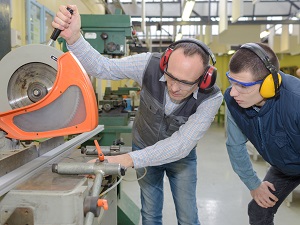Training and education are important tools for informing workers and managers about hazards and controls so they can work more safely and be more productive. Another role of education and training, however, is to provide workers and managers with a greater understanding of the safety and health program itself, so that they can contribute to its development and implementation.

Training and education provide employers, managers, supervisors, and workers with:
- Knowledge and skills needed to do their work safely and avoid creating hazards that could place themselves or others at risk.
- Awareness and understanding of hazards and how to identify, report, and control them.
- Specialized training when their work involves unique hazards.
Effective training and education can be provided outside a formal classroom setting. Peer-to peer training, weekly safety meetings, on-the-job training, daily toolbox talks, and worksite demonstrations can be effective in conveying safety concepts, ensuring understanding of hazards and their controls, and promoting good work practices.
All training should be provided in the language and at a literacy level that workers can understand.

PROGRAM AWARENESS TRAINING
Managers, supervisors, and workers all need to understand the structure, plans, and procedures of the health and safety program.
Provide training to all managers, supervisors, workers, contractors, and temporary agency workers on key topics like:
- Safety and health policies, goals, and procedures
- Functions of the safety and health program
- How to ask questions or voice concerns about the program
- Reporting procedures for hazards, injuries, illnesses, and near misses
- Emergency procedures
- Employer’s responsibilities under the program
- Workers’ rights under the OSH Act
- Safety and health hazards of the workplace and the controls for those hazards
Confirm, as part of the training, that all workers have the right to report injuries, incidents, hazards, and concerns and to fully participate in the program without fear of retaliation.

TRAINING FOR LEADERSHIP ROLES
Employers, managers, and supervisors are responsible for worker safety, yet sometimes have little training on safety-related concepts and techniques. They can benefit from specific training that allows them to fulfill their leadership roles in the program.
Reinforce their leadership responsibilities under the OSH Act along with training on guaranteed workers’ rights.
Instruct those in leadership roles on the fundamental concepts and techniques for recognizing hazards and the methods of controlling them, including the hierarchy of controls.
Train leadership on the correct procedures for responding to reports of injuries, illnesses, and incidents, including ways to avoid discouraging reporting. All organization leaders should be trained on incident investigation techniques, including root cause analysis.
For construction leadership, consider providing the OSHA 30-hour safety course.

SAFETY TRAINING FOR SPECIFIC ROLES
Additional training may be needed to ensure that workers can incorporate any assigned safety and health responsibilities into their daily routines and activities.
Instruct workers on how to report injuries, illnesses, incidents, and concerns. If a computerized reporting system is used, ensure that all employees have the basic computer skills and computer access sufficient to submit an effective report.
Workers assigned to specific roles within the safety and health program should receive training on how to carry out those responsibilities, which might include hazard recognition, control implementation, incident investigation, and program evaluation and improvement. Provide opportunities for workers to ask questions and provide feedback during and after the training.
As the health and safety program evolves, institute a more formal process for determining the training needs of workers responsible for developing, implementing, and maintaining the program.

TRAINING FOR HAZARD RECOGNITION AND CONTROLS
Providing workers with an understanding of hazard recognition and control, and actively involving them in the process, can help to eliminate hazards before an incident occurs.
Workers should be able to understand and recognize the hazards they may encounter in their own jobs, as well as more general work-related hazards.
Train workers on techniques for identifying hazards, such as job hazard analysis.
Instruct workers on concepts and techniques for controlling hazards, including the hierarchy of controls and its importance.
Workers should also receive training on the proper implementation of work practice and administrative controls, as well as when and how to wear required personal protective equipment (PPE).
Provide additional training, as necessary, when a change in facilities, equipment, processes, materials, or work organization could increase hazards, and whenever a worker is assigned a new task.
For construction workers, provide additional training, as necessary, when construction progresses. There may be learning opportunities when new trades or equipment arrive at the job site to perform the next phase of the project.

This article has been adapted from material provided by OSHA Publication 3885 Recommended Practices for Safety and Health Programs.
.jpeg)



